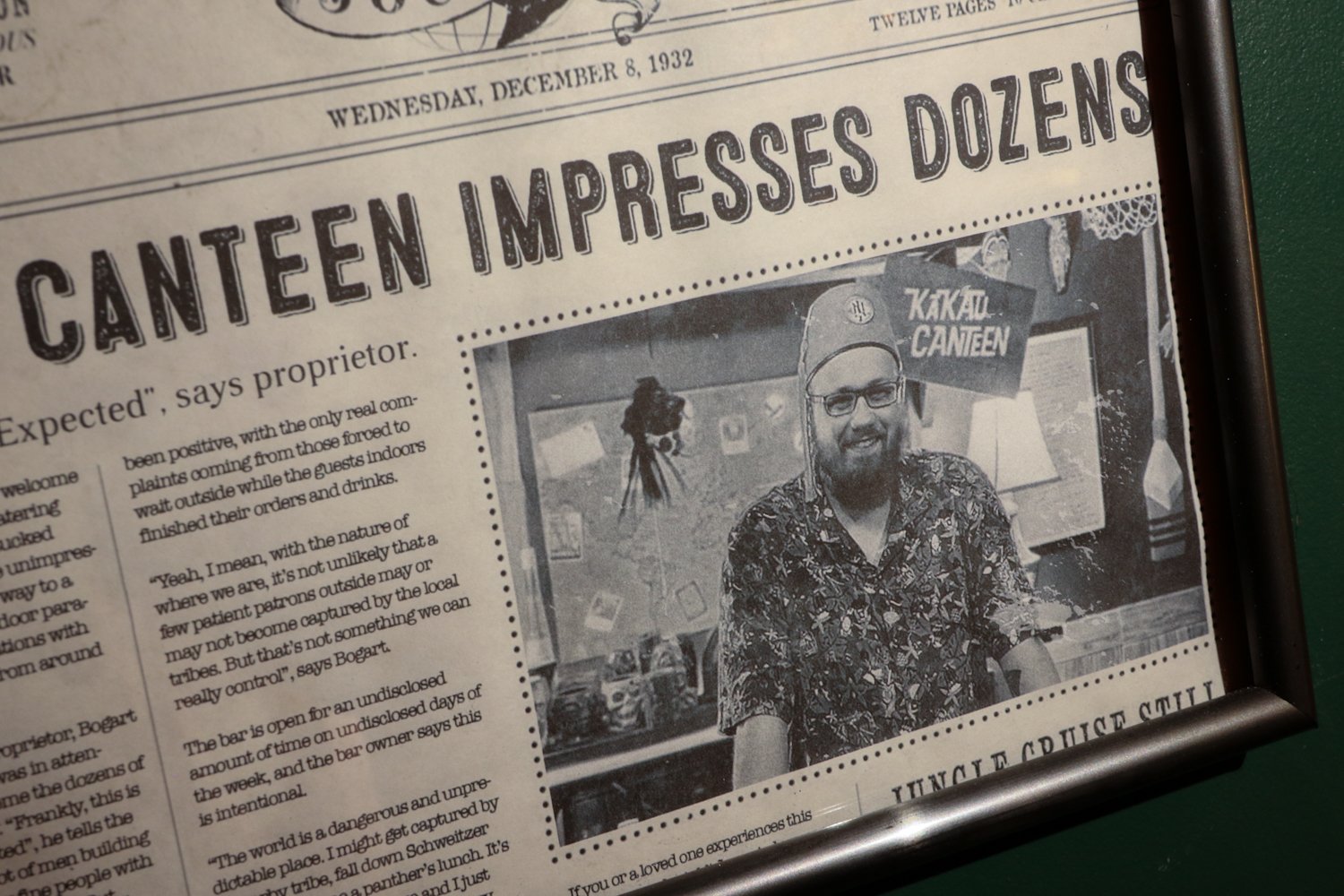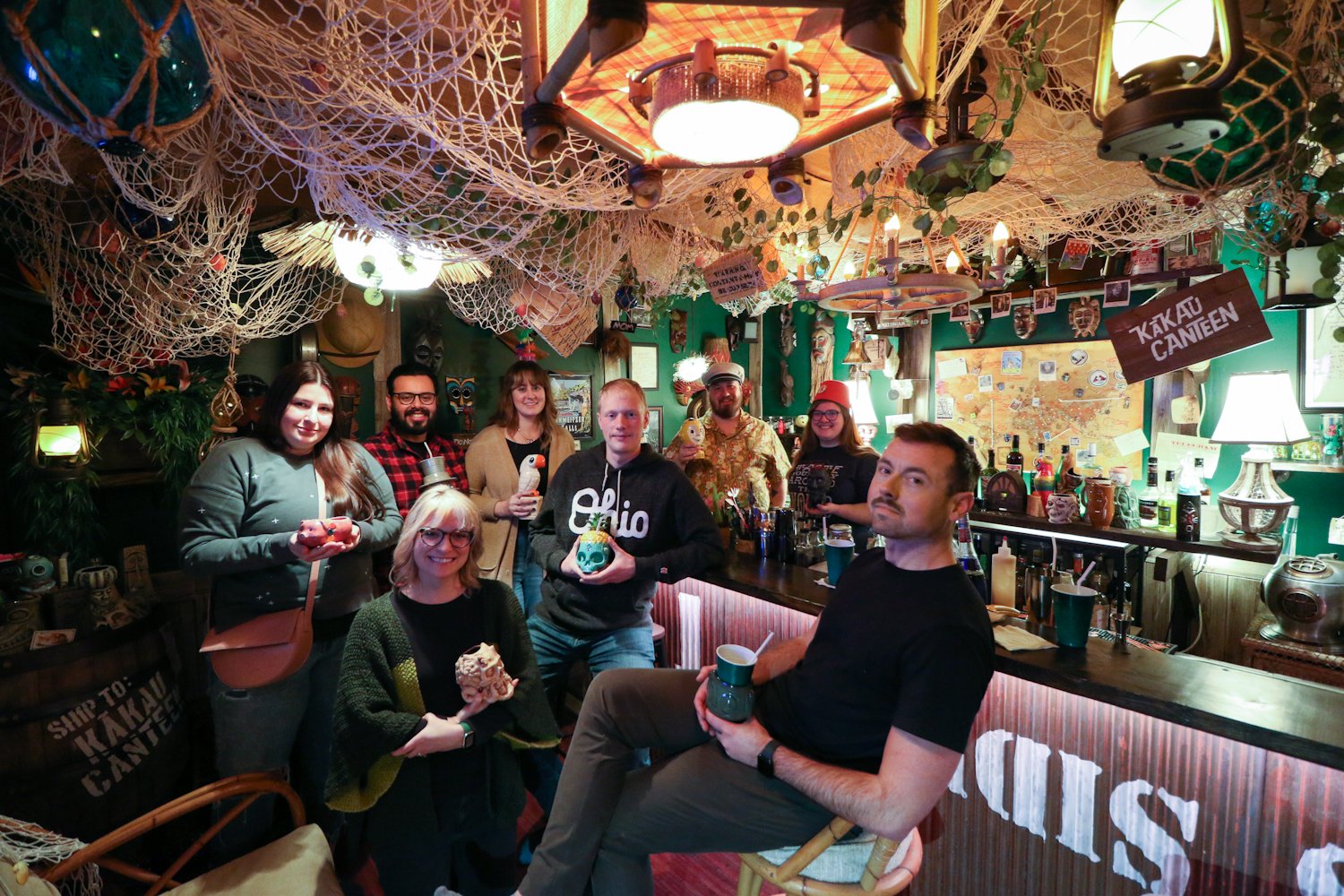The Kakau Canteen
A black and white photograph of the poor man is featured on the menu. The story printed alongside it states that Mr. Beauregard Coriell had delivered “bourbon barrels at a reasonable price for years.”
The Kākau‘s menu featuring the loyal Beauregard.
When you order “Beauregard’s Fate,” it comes served in a shark-shaped mug splashed with red bitters. A fitting, if not morbid, tribute to the rum-runner who now has “a few less appendages.”
A “shark eye,” or as it’s known within the canteen: “Beauregard’s Fate.”
The spirits he provided go down easy when paired with “passion fruit syrup, lemon juice, rye whiskey, maraschino liqueur, curaçao, and tiki bitters.” Drink enough of those and your eyes will have an even more difficult time focusing on the surroundings illuminated by the dim lanterns strung from the ceiling.
Occasionally, the generator sputters and causes them to flicker. That’s the least of your concerns, though. Looking out the window, you’ll see that the nearby volcano is simmering, and if you touch the wrong artifact on display—you’ll invite the fury of angry gods who come to life in the eyes of ancient masks.
Then there’s the cannon protruding through the wall. Every time it fires, a thunderous explosion rocks the room and smoke settles on the bartop. Although, that mist could just be from a beverage that the bartender has lit on fire. Either way, the canteen is full of surprises. Especially when you walk out the door and find yourself not in the tropics, but in the basement of a suburban home.
The Kākau was hidden within the basement of this suburban Columbus, Ohio home.
The crew for this excursion hailed from several walks of my life. I’d known Nate for most of my years and now by extension, his wife Amy. Thanks to my lifelong affection for Cincinnati, I’d met Travis and Allie. Via my support for Cincinnati’s soccer team, I’d gotten to know Leo and Allison. To an outside observer, this might’ve seemed like the perfect cast for an intervention. Especially when you factored in Jordan, a man I’d met during those formidable years working at an amusement park. But a bar, even a homemade one, probably isn’t the the best place for organizing life-altering help. Plus, there’d been no surprise, this assemblage had been invited. A group who were the kinds of folks I could call up and ask: “wanna go to a basement tiki bar this weekend?” Their answers had been enthusiastic affirmations, which is how we all found ourselves greeted at the door by Jordan’s welcoming wife, Sarah—the guide who escorted us down the stairs to her husband. Donning the hat of a ship’s captain and a smile, Jordan stood among his creation: The Kākau Canteen.
Jordan and Sarah Hill.
To set the proper tone, let’s be clear: this place wasn’t a “man cave,” the kind of spot where dads nod off in recliners beneath faded posters of Pete Rose. The basement of the Hills’ home just happened to be where there was space for what could simply be described as a “passion project,” but really deserved much more credit than that. Without exaggeration, the canteen was easily on par with the kinds of experiences served up by the likes of theme park giants Disney and Universal Studios. This was more than just a bar serving themed cocktails and fitted with appropriate decor. Everything, and I mean everything, had a story to it. Even the smallest details helped further an immersive experience.
The Kākau featured many intricately detailed decorations such as this telegram which furthered the story of the “artifacts” on the walls.
The bar’s liquor license was apparently “revoked” due to some mix up involving rum and gasoline.
A warning regarding “last week’s fruit.”
Last week’s fruit.
Postcards, flyers, and photographs—each decoration held a reference and backstory. Occasionally, the soundtrack would be interrupted as custom, pre-recorded messages played from hidden speakers serving as the canteen’s “radio.” If you touched something cheekily labeled “DO NOT TOUCH,” a motion sensor would trigger a series of audio and lighting effects that completely transformed the room.
The “Do Not Touch” mask effect. Via Jordan A. Hill Design.
Looking out the lone window that was really a bamboo framed television screen, visitors could take in the volcanic vista—a scene that could be altered to reflect the time of day, weather, or occasion.
The Kākau‘s sole “window.”
While Jordan had been responsible for creating this world, it was Sarah who curated the libations, herself becoming the talented tender of a bar that kept patrons clamoring to try every item on the menu.
One of Sarah’s “flaming” cocktails.
Back when when the COVID-19 pandemic initially set in, many folks took up new hobbies or set about new projects. Jordan Hill was no different in that regard, but I believe it’s fair to stay he was a bit more ambitious than most. He described the canteen as his “playground,” a place where he could combine his personal creativity and professional skills into something that could be shared. The concept had its roots in a bad night out a few years back. After Jordan and Sarah were put off by the beverages of a local watering hole, they happened upon their first tiki bar. There, they had their first sips of “tropical” drinks and toasted to a newfound interest.
A mug from the former Kahiki Supper Club, a once iconic tiki bar and restaurant that had been a fixture of Columbus, Ohio.
Swizzle sticks from the defunct Kahiki Supper Club.
Tiki is an American creation inspired by the cultures of Oceania, the Caribbean, Hawaii, and many other trans-Pacific locales. A concept born from the aftermath of Prohibition and further fueled by the experiences of American soldiers returning from the Pacific Campaign of World War Two. In the ensuing decades, Tiki would become heavily influenced by Hollywood depictions and tourism trends. After a decline, the 21st Century brought about a revival. Alongside new bars opening in the nightlife hubs of American cities, social media became the place to share the stories of Tiki enthusiasts. Sometimes it’d just be a collection of vintage mugs, other times it’d be a mixologist showcasing a new drink, but the most entertaining and enthralling ones are the likes of what Jordan had built: full-scale, homemade bars. And as far as I could tell (no matter how many free drinks he gave me), he had not one of the best, but the best.
Leo & Nate modeling the headwear made available to Kākau patrons.
As my friends socialized within the tropical confines of the Kākau one afternoon, Jordan and I spoke off to the side. He reiterated how this space had been an amalgamation of all his interests, whether they came from his childhood or his career. Here, his love for theme parks, taste for Tiki drinks, experiences with video animation, and passion for design merged. Every element had his personal touch embedded within. The canteen wasn’t just a place to host friends, it was a space that constantly taught him new skills as he sought to add fresh features and push the experience even further.
Example of the “cannon” effect. In the top right of the lower video, you can see the cannon fire.
If the Kākau Canteen had been a “real” bar in the sense of it standing as a regular business open to the public, I can’t even begin to imagine the success it could’ve found and attention it would’ve received. Patrons wouldn’t have just been in for an evening of strong drinks, but an experience unlike any other bar on their block. Which begged the question: how long until the Hills turned this labor of love into a “traditional” business?
“Low stakes,” was what it boiled down to. Down in his bar, Jordan didn’t need to worry about customers, profits, inventory, or a reality TV ambush from the likes of Jon Taffer. The canteen was his own world, a place for him and his guests to not just bear witness to his creation, but to enjoy time together. As I watched three different groups of friends immediately bond over conversation, alcohol, and laughter within those surroundings—I totally got it.
We had been the canteen’s final customers, though. Immediately after departing, Jordan and Sarah began taking everything down. Within a matter of days, their basement returned to simply being just that—a basement. But the reason for the Kākau’s demise should be of no surprise. The project, and its spread throughout the internet, had garnered attention which in turn led Jordan to a new career opportunity. One that would take him and Sarah to Orlando and allow him to use all those skills he’d acquired and honed while creating the canteen. Today, his work now influences the likes of the theme parks who originally inspired him. And the bar itself? Well, it’s all in storage. Waiting for an eventual rebirth as “Club MayDay.” It’s merely conceptual for now, but also a place where I hope to toast Jordan and Sarah again one day. All while taking in what amazing experience they’ve come up with next.
The final visitors alongside the proprietors of the amazing Kākau Canteen.
A sincere and heartfelt thank-you to Jordan and Sarah Hill for not just their welcoming hospitality (and great drinks), but for sharing their story with my friends and I. The world needs more folks like you two.
And thank you to Amy, Nate, Allie, Travis, Allison, and Leo for coming with me to hang out. You are all wonderful people.
Since 2007, the content of this website (and its former life as Queen City Discovery) has been a huge labor of love.
If you’ve enjoyed stories like The Ghost Ship, abandoned amusement parks, the Cincinnati Subway, Fading Ads, or others over the years—might you consider showing some support for future projects?

























